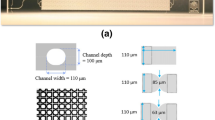Abstract
We study the formation of oil droplets from an initially trapped large oil ganglion under surfactant flooding, using a microfluidic device consisting of a two-dimensional array of regularly spaced square posts. We observe that above a critical capillary number for oil mobilization, breakage of the ganglion results in the formation of either trapped patches spanning multiple pores or numerous mobile droplets that exit the device at a velocity comparable to the average flooding fluid velocity. These mobile droplets, however, are only observed when above a secondary capillary number threshold. The formation of these droplets is found to involve the simultaneous occurrence of three different passive droplet generation mechanisms where a droplet is formed as it is pulled by perpendicular fluid flow, as it is pulled by co-axial fluid flow, and or as it splits due to collision with a post. Our results show that oil breakthroughs only occur when the oil is in the form of mobile droplets, suggesting that droplet formation can be an important condition for the mobility of residual oil in porous media. Additionally, this post-array microfluidic device can be used for the production of monodisperse droplets whose size can be controlled by the spacing of the posts.




Similar content being viewed by others
References
Akbari, S., Pirbodaghi, T., Kamm, R.D., Hammond, P.T.: A versatile microfluidic device for high throughput production of microparticles and cell microencapsulation. Lab Chip 17, 2067–2075 (2017). https://doi.org/10.1039/c6lc01568a
Amit, L., Naar, D., Gloukhovski, R., la O, G.J., Suss, M.E.: A single-flow battery with multiphase flow. Chemsuschem 14, 1068–1073 (2021). https://doi.org/10.1002/cssc.202002135
Datta, S.S., Dupin, J.B., Weitz, D.A.: Fluid breakup during simultaneous two-phase flow through a three-dimensional porous medium. Phys. Fluids (2014). https://doi.org/10.1063/1.4884955
De Menech, M., Garstecki, P., Jousse, F., Stone, H.A.: Transition from squeezing to drip** in a microfluidic T-shaped junction. J. Fluid Mech. 595, 141–161 (2008). https://doi.org/10.1017/s002211200700910x
Dias, M.M., Payatakes, A.C.: Network models for 2-phase flow in porous-media 2. Motion of oil ganglia. J. Fluid Mech. 164, 337–358 (1986a). https://doi.org/10.1017/s0022112086002586
Dias, M.M., Payatakes, A.C.: Network models for 2-phase flow in porous-media 1. Immiscible microdisplacement of nonwetting fluids. J. Fluid Mech. 164, 305–336 (1986b). https://doi.org/10.1017/s0022112086002574
Dong, L., et al.: Integrated microfluidic device for drug studies of early C elegans embryogenesis. Adv. Sci. (2018). https://doi.org/10.1002/advs.201700751
Foster, W.R.: A low-tension waterflooding process. J. Petrol. Technol. 25, 205–210 (1973). https://doi.org/10.2118/3803-pa
Guo, H., et al.: Proper use of capillary number in chemical flooding. J. Chem. (2017). https://doi.org/10.1155/2017/4307368
Guo, H., Song, K., Hilfer, R.: A brief review of capillary number and its use in capillary desaturation curves. Transp. Porous Media 144, 3–31 (2022). https://doi.org/10.1007/s11242-021-01743-7
Hirasakl, G.J.: Wettability: fundamentals and surface forces. SPE Form. Eval.eval. 6, 217–226 (1991). https://doi.org/10.2118/17367-pa
Iglauer, S., Ferno, M.A., Shearing, P., Blunt, M.J.: Comparison of residual oil cluster size distribution, morphology and saturation in oil-wet and water-wet sandstone. J. Colloid Interface Sci. 375, 187–192 (2012). https://doi.org/10.1016/j.jcis.2012.02.025
Krummel, A.T., Datta, S.S., Munster, S., Weitz, D.A.: Visualizing multiphase flow and trapped fluid configurations in a model three-dimensional porous medium. AIChE J. J. 59, 1022–1029 (2013). https://doi.org/10.1002/aic.14005
Lake, L., Johns, R. T., Rossen, W. R. & Pope, G. A. In: Fundamentals of Enhanced Oil Recovery, Society of Petroleum Engineers, (2014)
Lenormand, R. In: Po-zen Wong (ed.) Experimental Methods in the Physical Sciences vol. 35, pp. 43–68. Academic Press, Cambridge (1999)
Melrose, J.C., Brandner, C.F.: Role of capillary forces in determining microscopic displacement efficiency for oil-recovery by waterflooding. J. Can. Pet. Technol. 13, 54–62 (1974). https://doi.org/10.2118/74-04-05
Oughanem, R., et al.: A multi-scale investigation of pore structure impact on the mobilization of trapped oil by surfactant injection. Transp. Porous Media 109, 673–692 (2015). https://doi.org/10.1007/s11242-015-0542-5
Protiere, S., Bazant, M.Z., Weitz, D.A., Stone, H.A.: Droplet breakup in flow past an obstacle: a capillary instability due to permeability variations. Europhys. Lett.. Lett. (2010). https://doi.org/10.1209/0295-5075/92/54002
Rucker, M., et al.: From connected pathway flow to ganglion dynamics. Geophys. Res. Lett. Res. Lett. 42, 3888–3894 (2015). https://doi.org/10.1002/2015gl064007
Sheng, J. J. In: James J. Sheng (ed.) Modern Chemical Enhanced Oil Recovery, pp. 239–335. Gulf Professional Publishing, Houston, (2011)
Stolovicki, E., Ziblat, R., Weitz, D.A.: Throughput enhancement of parallel step emulsifier devices by shear-free and efficient nozzle clearance. Lab Chip 18, 132–138 (2018). https://doi.org/10.1039/c7lc01037k
Utada, A.S., Fernandez-Nieves, A., Stone, H.A., Weitz, D.A.: Drip** to jetting transitions in coflowing liquid streams. Phys. Rev. Lett. (2007). https://doi.org/10.1103/PhysRevLett.99.094502
Wei, B., et al.: Nuclear magnetic resonance (NMR) map** of remaining oil distribution during sequential rate waterflooding processes for improving oil recovery. J. Pet. Sci. Eng. (2020). https://doi.org/10.1016/j.petrol.2020.107102
Yang, W., Lu, J., Wei, B., Yu, H., Liang, T.: Micromodel studies of surfactant flooding for enhanced oil recovery: a review. ACS Omega 6, 6064–6069 (2021). https://doi.org/10.1021/acsomega.0c05750
Zagnoni, M., Anderson, J., Cooper, J.M.: Hysteresis in multiphase microfluidics at a T-junction. Langmuir 26, 9416–9422 (2010). https://doi.org/10.1021/la1004243
Zhu, P.A., Wang, L.Q.: Passive and active droplet generation with microfluidics: a review. Lab Chip 17, 34–75 (2017). https://doi.org/10.1039/c6lc01018k
Acknowledgements
This research was supported by Chinese University of Petroleum Bei**g through the Harvard-CUPB joint laboratory on Petroleum Science and the Harvard MRSEC (NSF, DMR-2011754). We thank Profs. J. Bibette and H. A. Stone for insightful discussions.
Author information
Authors and Affiliations
Corresponding authors
Ethics declarations
Conflicts of interest
There are no conflicts to declare.
Additional information
Publisher's Note
Springer Nature remains neutral with regard to jurisdictional claims in published maps and institutional affiliations.
Supplementary Information
Below is the link to the electronic supplementary material.
Supplementary file2 (MP4 6237 KB)
Supplementary file3 (MP4 6341 KB)
Rights and permissions
Springer Nature or its licensor (e.g. a society or other partner) holds exclusive rights to this article under a publishing agreement with the author(s) or other rightsholder(s); author self-archiving of the accepted manuscript version of this article is solely governed by the terms of such publishing agreement and applicable law.
About this article
Cite this article
Haney, B., Cochard, T., Julien, A. et al. Oil Ganglia Mobility Enhancement by Droplet Formation for Surfactant Flooding in Porous Media. Transp Porous Med 151, 585–597 (2024). https://doi.org/10.1007/s11242-023-02050-z
Received:
Accepted:
Published:
Issue Date:
DOI: https://doi.org/10.1007/s11242-023-02050-z




